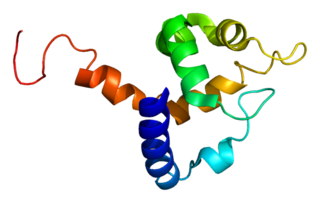
T-cell acute lymphocytic leukemia protein 1 is a protein that in humans is encoded by the TAL1 gene.

Dynamin-2 is a protein that in humans is encoded by the DNM2 gene.

LIM domain only 2, also known as LMO2, RBTNL1, RBTN2, RHOM2, LIM Domain Only Protein 2, TTG2, and T-Cell Translocation Protein 2, is a protein which in humans is encoded by the LMO2 gene.

CCAAT/enhancer-binding protein delta is a protein that in humans is encoded by the CEBPD gene.

Exosome component 2, also known as EXOSC2, is a protein which in humans is encoded by the EXOSC2 gene.

AF4/FMR2 family member 1 is a protein that in humans is encoded by the AFF1 gene. At its same location was a record for a separate PBM1 gene, which has since been withdrawn and considered an alias. It was previously known as AF4.

Hepatic leukemia factor is a protein that in humans is encoded by the HLF gene.

T-cell leukemia homeobox protein 1 is a protein that in humans is encoded by the TLX1 gene, which was initially named HOX11.

Homeobox A4, also known as HOXA4, is a protein which in humans is encoded by the HOXA4 gene.

Septin-6 is a protein that in humans is encoded by the SEPT6 gene.

Phosphatidylinositol-5-phosphate 4-kinase type-2 alpha is an enzyme that in humans is encoded by the PIP4K2A gene.

PHD finger protein 6 is a protein that in humans is encoded by the PHF6 gene.

Integrin beta-8 is a protein that in humans is encoded by the ITGB8 gene.

Protein lyl-1 is a protein that in humans is encoded by the LYL1 gene.

Protein ENL is a protein that in humans is encoded by the MLLT1 gene.

Pituitary tumor-transforming gene 1 protein-interacting protein (PTTG1), also known as PTTG1-binding factor (PBF), is a poorly characterised protein that in humans is encoded by the PTTG1IP gene located within the chromosomal region 21q22.3.

AT-rich interactive domain-containing protein 5B is a protein that in humans is encoded by the ARID5B gene.

Metalloreductase STEAP1 is an enzyme that in humans is encoded by the STEAP1 gene.

RNA-binding protein 39 is a protein that in humans is encoded by the RBM39 gene.

T-cell acute lymphocytic leukemia 2, also known as TAL2, is a protein which in humans is encoded by the TAL2 gene.


















